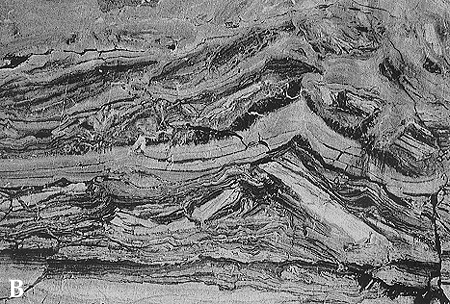

Tepee structure
Plate 107


Tepee structure
Plate 107
The name of this structure derives from the rooflike attitude of deformed and broken beds. It is found mainly in carbonate and evaporitic sediments, in which early diagenesis or direct precipitation results in hardened beds and crusts. A main cause of deformation is the dilatancy of materials, in this case; dilation can be caused, in its turn, by thermal or chemical processes inducing mechanical effects, such as heat exchanges, hydration-dehydration, and force of crystallization of salts among others.
In plan view (A), tepees are polygonal structures with raised edges. The pattern is thus similar to that of desiccation fissures, but the relief is inverted. The dilation of superficial beds, or the shrinkage of underlying sediments, generates compressional forces in the horizontal plane. This happens because the materials are laterally confined and cannot expand freely. Beds "rear up" under compression, and tend to bend. If they are not elastic enough, bending cannot occur: brittle carbonate beds, for example, are ruptured, while plastic, hydrated materials are folded (see plate 104 B). In other words, they respond to stress with a permanent, anelastic deformation. In "roof tops," facing edges of broken beds thrust over each other. The formation of these "anticlines" and overthrusts allows dilation to occur, as is confirmed by the voids that are created below the interface.
Tepee structures are found in hot and dry areas, in environments like salt pans, sabkhas, chotts, playa (ephemeral) lakes and supratidal zones of coastal areas. In the fossil state, they thus represent indicators of similar environments and, more generally, of subaerial conditions. The example shown in B derives from a Mesozoic (Triassic) unit of southern Alps, the Calcare Rosso.
As early diagenetic processes are involved in tepee formation, the structure might be classified as secondary as well (see last section, plates 162 to 178). Moreover, later diagenetic effects are visible in fossil occurrences; look, for example, at the dark coatings in B, representing pore-filling cement crystals. This point stresses that classifications are useful in science as guideline but pigeonholing of natural objects is difficult and largely arbitrary.
| Photos: A G. G. Ori 1992; B F. Jadoul 1992. |